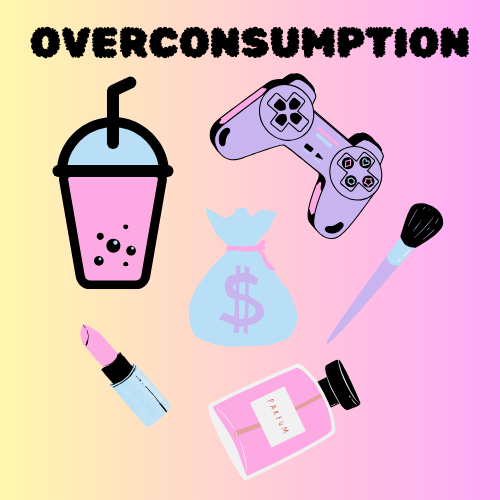When her eyes flickered open in the morning, there were only a few things that got her out of bed. A ten dollar new serum from Walmart that promised a glowy face, the one SHEIN sweater that turned out thick out of the four ordered, and a rotting avocado she swore she would eat because of the price. But as soon as she caught a glimpse of herself in the mirror she frowned. She really wasn’t any prettier than the day before, and all that was left was the guilt from money wasted.
As modern media progresses, this is the basis of a morning routine for thousands of young girls. Between “Get ready with me” videos and hidden brand deals where influencers insist on a product’s genuineness, it’s not hard to see the subtle standard placed on today’s generation for overconsumption.
Over consumption is characterized by means of consuming more resources than necessary or available, and the examples are endless.
“You see all these media influencers with all of this stuff, but at the same time, they get a lot of that stuff for free. So you wanna go out and have everything that they have because you want to be cool basically, but you can’t have everything,” junior Nila Peterson said.
Beauty products are just one industry of many dedicated to addicting their consumers to a desirable outcome, even trapping young kids in the cycle. A phenomenon known as “Sephora kids” shows preteen girls spending money on expensive anti-aging and makeup products before they have even matured.
“You see the Sephora kids – that is so sad. They are starting at such a young age, and they think that they need this makeup but they really don’t,” Peterson said.
The concept of overconsumption in general has been culturally pushed for so long that attaining the newest items is a normalized idea to NS students.
“People are advertising it as normal to have all of these things, but in reality what’s it really helping? Is there a need for all of this?” senior Maren Maynes said.
Overconsumption growing common may seem like a minor issue, but it doesn’t just affect the consumers. It affects the planet the resources are coming from. With the increase in fast fashion websites such as Temu and Shein, online shopping has opened a new door to poor working conditions and is increasing the amount of waste in landfills.
“I researched all of this awful stuff that they did [Shein]- it’s just fast fashion and it’s just pieces of clothes you can wear for a few times before they wear out and they’re not good quality,” Peterson said. “So then I started thrifting a lot more of my clothes.”
One of the biggest dangers for youth of today is the fact that buying an excess amount of things is taking away money that could be saved for future housing, education, ect. With current inflation, many question how these teens with little to no savings are expected to work with the cost of living in the near future.
There are influencers who are making a paycheck claiming expensive things are the reward that is needed for dealing with how tough life can be. But there is also the fact that saving money can be helpful in the long run. The trap that overconsumption creates is one easy to fall into, and once the brain is hit with the pleasure of a new purchase, a trap hard to get out of.
“No one is going to know how to budget their money, or how to budget in their fun money or their spending money because it’s going to be the priority.” Maynes said.
Although materialism and fast fashion may not be a problem for everyone, scarcely anyone is a stranger to the concept of overconsumption whether they realize it or not. Over consuming can also take the form of overindulging in food, drinks, social media, and video games.



